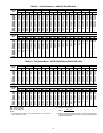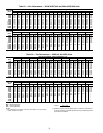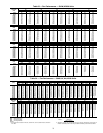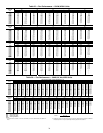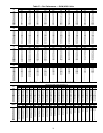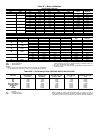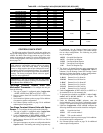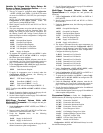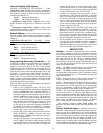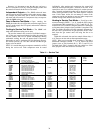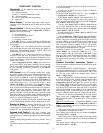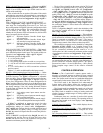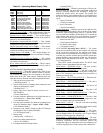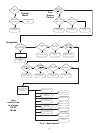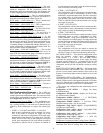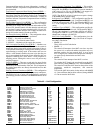
29
Indoor Air Quality (IAQ) Options
DEMAND CONTROLLED VENTILATION — Under
Configuration
IAQ
DCV.C, the following configuration
parameters should be set to establish the minimum and maxi-
mum points for outdoor air damper position during demand
controlled ventilation (DCV):
EC.MN Economizer Min.Position
IAQ.M IAQ Demand Vent Min.Pos.
Configuration
IAQ
DCV.C
IAQ.M is used to set the
absolute minimum vent position (or maximum reset) under
DCV.
Configuration
IAQ
DCV.C
EC.MN is used to set the
minimum damper position (or with no DCV reset). This is also
referenced in the economizer section.
Exhaust Options — The A Series units can be config-
ured with constant volume 2-stage power exhaust or modulat-
ing power exhaust. The following exhaust options should be
configured.
Configuration
BP
BF.CF=1 (Two-Stage Exhaust
Option) — For two-stage exhaust, under the Configuration
BP submenu, configure the following:
Configuration
BP
BF.CF=2 (Modulating Power Exhaust
Option) — For modulating exhaust, in the Configuration
BP submenu, configure the following:
Programming Operating Schedules — The
ComfortLink™ controls will accommodate up to eight differ-
ent schedules (Periods 1 through 8), and each schedule is
assigned to the desired days of the week. Each schedule
includes an occupied on and off time. As an example, to set an
occupied schedule for 8 AM to 5 PM for Monday through
Friday, the user would set days Monday through Friday to ON
for Period 1. Then the user would configure the Period 1
Occupied From point to 08:00 and the Period 1 Occupied To
point to 17:00. To create a different weekend schedule, the user
would use Period 2 and set days Saturday and Sunday to ON
with the desired Occupied On and Off times. To create a sched-
ule, perform the following procedure:
NOTE: By default, the time schedule periods are programmed
for 24 hours of occupied operation.
1. Scroll to the Configuration mode, and select CCN
CONFIGURATION (CCN). Scroll down to the Schedule
Number (Configuration
CCN
SC.OV
SCH.N). If
password protection has been enabled, the user will be
prompted to enter the password before any new data is
accepted. SCH.N has a range of 0 to 99. The default val-
ue is 1. A value of 0 is always occupied, and the unit will
control to its occupied set points. A value of 1 means the
unit will follow a local schedule, and a value of 65 to 99
means it will follow a CCN schedule. Schedules 2 to 64
are not used as the control only supports one internal/lo-
cal schedule. If one of the 2 to 64 schedules is configured,
then the control will force the number back to 1. Make
sure the value is set to 1 to use a local schedule.
2. Enter the Time Clock mode. Scroll down to the LOCAL
TIME SCHEDULE (SCH.L) sub-mode, and press
ENTER. Period 1 (PER.1) will be displayed. Press EN-
TER to configure Period 1.
3. Configure the beginning of the occupied time period for
Period 1 (OCC). Scroll down to OCC and press ENTER
to go into Edit mode. The first two digits of the 00.00 will
start flashing. Use the UP or DOWN key to display the
correct value for hours, in 24-hour (military) time. Press
ENTER and hour value is saved and the minutes digits
will start flashing. Use the same procedure to display and
save the desired minutes value. Press ESCAPE.
4. Configure the unoccupied time for period 1 (UNC).
Scroll down to UNC and press ENTER to go into Edit
mode. The first two digits of the 00.00 will start flashing.
Use the UP or DOWN key to display the correct value for
hours, in 24-hour (military) time. Press ENTER and hour
value is saved and the minutes digits will start flashing.
Use the same procedure to display and save the desired
minutes value. Press ESCAPE.
5. Scroll to DAYS and press ENTER. Scroll down to the
MON point. This point indicates if schedule 1 applies to
Monday. Use the ENTER command to go into Edit
mode, and use the UP or DOWN key to change the dis-
play to YES or NO. Scroll down through the rest of the
days and apply schedule 1 where desired. The schedule
can also be applied to a holiday. Press ESCAPE.
6. The first schedule is now complete. If a second schedule
is needed, such as for weekends or holidays, scroll down
and repeat the entire procedure for period 2 (PER.2). If
additional schedules are needed, repeat the process for as
many as are needed. Eight schedules are provided.
SERVICE TEST
General —
The units are equipped with a Service Test fea-
ture, which is intended to allow a service person to force the
unit into different modes of operation to test them. To use this
feature, enter the Service Test category on the local display and
place the unit into the test mode by changing Service
Test
TEST from OFF to ON. The display will prompt for the
password before allowing any change. The default password is
1111. Once the unit enters the Service Test mode, the unit will
shut down all current modes.
TEST — The TEST command turns the unit off (hard stop)
and allows the unit to be put in a manual control mode.
STOP — The STOP command completely disables the unit
(all outputs turn off immediately). Once in this mode, nothing
can override the unit to turn it on. The controller will ignore all
inputs and commands.
S.STP — Setting Soft Stop to YES turns the unit off in an
orderly way, honoring any time guards currently in effect.
FAN.F — By turning the FAN FORCE on, the supply fan is
turned on and will operate as it normally would, controlling
duct static pressure on VAV applications or just energizing the
fan on CV applications. To remove the force, press ENTER
and then press the UP and DOWN arrows simultaneously.
F.4.CH — The 4-Inch Filter Change Mode variable is used to
service the unit when 4-in. filters are used. When the filters
need to be changed, set Service Test
F.4 .CH = YES. The unit
will be placed in Service Test mode and the economizer will
move to the 40% open position to facilitate removal of the 4-in.
filters. After the filters have been changed, set Service
Test
F. 4. CH = NO to return the unit to normal operation.
The remaining categories: INDP, FANS, COOL, and
HEAT are sub-modes with separate items and functions. See
Table 41.
Service Test Mode Logic — Operation in the Service
Test mode is sub-mode specific except for the Independent sub-
mode. Leaving the sub-mode while a test is being performed
and attempting to start a different test in the new sub-mode will
cause the previous test to terminate. When this happens, the
new request will be delayed for 5 seconds. For example, if com-
pressors were turned on under the COOL sub-mode, any at-
tempt to turn on heating stages within the HEAT sub-mode
would immediately turn off the compressors and, 5 seconds lat-
er, the controller would honor the requested heat stages.
BP.P1 Power Exhaust On Setp.1
BP.P2 Power Exhaust On Setp.2
BP.SP Building Pressure Setp.



